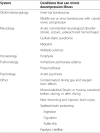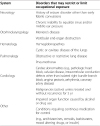KimBG. ChoiBS. KimEA. LeeJO. The investigation for the number of the professional divers and the condition of their health related to diving practices in Korea. 2005. Incheon, Korea: OSHRI, Korea Occupational Safety and Health Agency;p. 13–68. Korean.
SakongJ. YoonSK. LeeKS. HwangTY. LeeSW. Incidence, prevalence, and prevention of diving related disease of diving fisherman and breath-hold divers in Korea. 2006. Seoul, Korea: Ministry of Maritime Affairs & Fisheries;p. 27. Korean.
ParkSK. OhJW. An introduction to diving medicine and decompression Sickness. J Korean Med Assoc. 2012. 25:659–665. Korean. DOI:
10.5124/jkma.2012.55.7.659.
NewtonHB. Neurologic complications of scuba diving. Am Fam Physician. 2001. 25:2211–2218. PMID:
11417773.
MariebEN. KatjaH. Human Anatomy and Physiology. 2009. 8. San Francisco: Benjamin Cummings;p. 824.
CarlE. BartM. RobertT. JohnP. Diving medicine for scuba divers. 2013. 5. New York: Aqua Quest Pub;p. 11–29.
EckenhoffRG. OlstadCS. CarrodG. Human dose–response relationship for decompression and endogenous bubble formation. J Appl Physiol. 1990. 25:914–918. PMID:
2246178.
BeckerGD. ParellGJ. Barotrauma of the ears and sinuses after scuba diving. Eur Arch Otorhinolaryngol. 2001. 25:159–163. DOI:
10.1007/s004050100334. PMID:
11407445.
CarlE. BartM. RobertT. JohnP. Diving medicine for scuba divers. 2013. 5. New York: Aqua Quest Pub;p. 95–107.
SegevY. LandsbergR. FlissDM. MR imaging appearance of frontal sinus barotrauma. Am J Neuroradiol. 2003. 25:346–347. PMID:
12637280.
VannRD. MoonRE. FreibergerJJ. Decompression illness diagnosis and decompression study design. Aviat Space Environ Med. 2008. 25:797–798. DOI:
10.3357/ASEM.2316.2008. PMID:
18717122.
RichardDV. FrankKB. SimonJM. RichardEM. Decompression illness. Lancet. 2010. 25:153–164.
WeissLD. Van MeterKW. Cerebral air embolism in asthmatic scuba divers in a swimming pool. Chest. 1995. 25:1653–1654. DOI:
10.1378/chest.107.6.1653. PMID:
7781362.
MellemH. EmhjellenS. HorgenO. Pulmonary barotrauma and arterial gas embolism caused by an emphysematous bulla in a SCUBA diver. Aviat Space Environ Med. 1990. 25:559–562. PMID:
2369396.
BoveAA. Medical aspects of sport diving. Med Sci Sports Exerc. 1996. 25:591–595. PMID:
9148089.
Van LiewHD. FlynnET. Direct ascent from air and N2-O2 saturation dives in humans: DCS risk and evidence of a threshold. Undersea Hyperb Med. 2005. 25:409–419. PMID:
16509283.
CarlE. BartM. RobertT. JohnP. Diving medicine for scuba divers. 2013. 5. New York: Aqua Quest Pub;p. 150–151.
TomSN. Arterial gas embolism and decompression sickness. Physiology. 2002. 25:77–81.
MitchellSJ. DooletteDJ. Selective vulnerability of the inner ear to decompression sickness in divers with right-to-left shunt: the role of tissue gas supersaturation. J Appl Physiol. 2009. 25:298–301. PMID:
18801958.
CommandUSNSS. US Navy diving manual. 6th rev. Vol. 5. Diving medicine and recompression chamber operations. 2008. Washington, DC: Aqua Press.
FrancisTJ. MitchellSJ. . Pathophysiology of decompression sickness. Diving medicine. 2004. 4. Philadelphia: Elsevier Saunders Pub;p. 175.
TetzlaffK. ShankES. MuthCM. Evaluation and management of decompression illness - an intensivist’s perspective. Intensive Care Med. 2003. 25:2128–2136. DOI:
10.1007/s00134-003-1999-1. PMID:
14600806.
BoussugesA. BlancP. MolenatF. BergmannE. SaintyJM. Haemoconcentration in neurological decompression illness. Int J Sports Med. 1996. 25:351–355. DOI:
10.1055/s-2007-972859. PMID:
8858406.
ZwirewichCV. MüllerNL. AbboudRT. LepawskyM. Noncardiogenic pulmonary edema caused by decompression sickness: rapid resolution following hyperbaric therapy. Radiology. 1987. 25:81–82. PMID:
3823462.
BensonJ. AdkinsonC. CollierR. Hyperbaric oxygen therapy of iatrogenic cerebral arterial gas embolism. Undersea Hyperb Med. 2003. 25:117–126. PMID:
12964855.
GemppE. BlatteauJE. StephantE. PontierJM. ConstantinP. PenyC. MRI findings and clinical outcome in 45 divers with spinal cord decompression sickness. Aviat Space Environ Med. 2008. 25:1112–1116. DOI:
10.3357/ASEM.2376.2008. PMID:
19070307.
DunfordRG. VannRD. GerthWA. PieperCF. HugginsK. WacholtzC. BennettPB. The incidence of venous gas emboli in recreational diving. Undersea Hyperb Med. 2002. 25:247–259. PMID:
12797666.
LeitchDR. GreenRD. Pulmonary barotrauma in divers and the treatment of cerebral arterial gas embolism. Aviat Space Environ Med. 1986. 25:931–938. PMID:
3778391.
MoonRE. SheffieldPJ. Guidelines for treatment of decompression illness. Aviat Space Environ Med. 1997. 25:234–243. PMID:
9056035.
BalldinUI. Effects of ambient temperature and body position on tissue nitrogen elimination in man. Aerosp Med. 1973. 25:365–370. PMID:
4694843.
DrummondJC. MooreSS. The influence of dextrose administration on neurological outcome after temporary spinal cord ischemia in the rabbit. Anesthesiology. 1989. 25:64–70. DOI:
10.1097/00000542-198901000-00014. PMID:
2912317.
ZornowMH. SchellerMS. ToddMM. MooreSS. Acute cerebral effects of isotonic crystalloid and colloid solutions following cryogenic brain injury in the rabbit. Anesthesiology. 1988. 25:180–184. DOI:
10.1097/00000542-198808000-00005. PMID:
2457341.
HelpsSC. GormanDF. Air embolism of the brain in rabbits pretreated with mechlorethamine. Stroke. 1991. 25:351–354. DOI:
10.1161/01.STR.22.3.351. PMID:
2003304.
SteiglemanA. ButlerF. ChhoeuA. O’MalleyT. BowerE. GiebnerS. Optic neuropathy following an altitude exposure. Aviat Space Environ Med. 2003. 25:985–989. PMID:
14503679.
BennettM. MitchellS. DominguezA. Adjunctive treatment of decompression illness with a non-steroidal anti-inflammatory drug tenoxicam. Undersea Hyperb Med. 2003. 25:195–205. PMID:
14620099.
TalpalarAE. GrossmanY. CNS manifestations of HPNS. Undersea Hyperb Med. 2006. 25:205–210. PMID:
16869534.
BennettPB. . Inert gas narcosis and high-pressure nervous syndrome. Diving medicine. 2004. 4. Philadelphia: Elsevier Saunders Pub;p. 231–232.
ClarkJM. ThomSR. . Toxicity of oxygen, carbon dioxide, and carbon monoxide. Diving medicine. 2004. 4. Philadelphia: Elsevier Saunders Pub;p. 241.
BittermanH. Bench-to-bedside review: oxygen as a drug. Crit Care. 2009. 25:205. DOI:
10.1186/cc7151. PMID:
19291278.
ClarkJM. LambertsenCJ. GelfandND. PisarelloJB. RossmanMD. EliasJA. Effects of prolonged oxygen exposure at 1.5, 2.0, or 2.5 ATA on pulmonary function in men (Predictive Studies V). J Appl Physiol. 1999. 25:243–259. PMID:
9887137.
ClarkJM. ThomSR. . Toxicity of oxygen, carbon dioxide, and carbon monoxide. Diving medicine. 2004. 4. Philadelphia: Elsevier Saunders Pub;p. 242.
MillarIL. MouldeyPG. Compressed breathing air–the potential for evil from within. Diving Hyperbaric Med. 2008. 25:145–148.
KenneyIJ. SonksenC. Dysbaric osteonecrosis in recreational divers: a study using magnetic resonance imaging. Undersea Hyperb Med. 2010. 25(5):281–288. PMID:
20929185.
CimsitM. IlgezdiS. CimsitC. UzunG. Dysbaric osteonecrosis in experienced dive masters and instructors. Aviat Space Environ Med. 2007. 25(12):1150–1154. DOI:
10.3357/ASEM.2109.2007. PMID:
18064920.
DennisNW. DavidHE. . Aseptic necrosis of bone. Diving medicine. 2004. 4. Philadelphia: Elsevier Saunders Pub;p. 428.










 PDF
PDF Citation
Citation Print
Print


 XML Download
XML Download